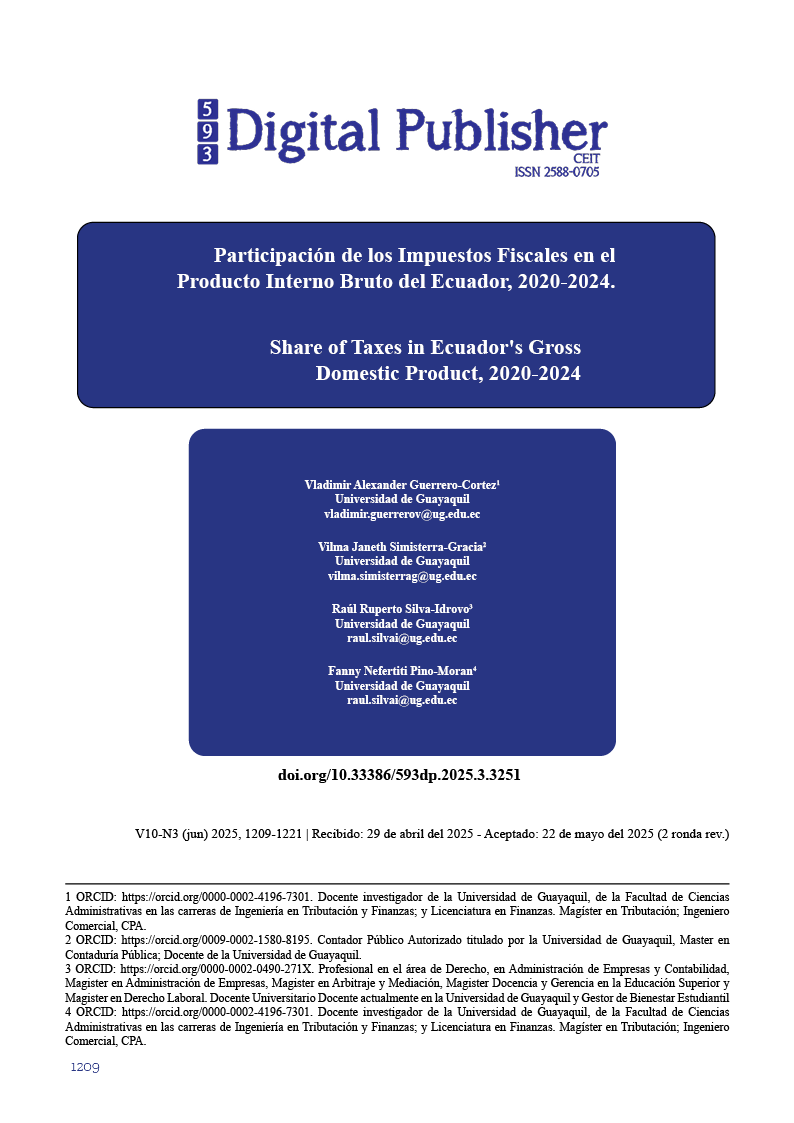Share of Taxes in Ecuador's Gross Domestic Product, 2020-2024
Main Article Content
Abstract
The research aims to analyze the participation of fiscal taxes in Ecuador's Gross Domestic Product (GDP) for the period 2020-2024. The variables used for the development of the research are: as a dependent variable to the Gross Domestic Product (GDP) and as an independent variable to Fiscal Taxes. The type of research used is descriptive, allowing the analysis of the behavior of the selected variables. The contribution made by the country's most representative fiscal taxes to the Gross Domestic Product (GDP) is analyzed, considering as a sample: the Value Added Tax (VAT), Income Tax (IR), Tariff Taxes (IA), Special Consumption Tax (ICE), Other Taxes and Emergency Taxes. The analysis determines that fiscal taxes maintain a 13% share of the growth of the Gross Domestic Product (GDP), in the periods corresponding to the year 2020 to 2024. The study determines that during the analysis period, the tax that contributes the most to Gross Domestic Product (GDP) growth is the Value Added Tax (VAT). It maintains an upward trend from 2020 to 2024, with the exception of 2023, when revenues decreased. Similarly, the research results show that the second-largest tax in Gross Domestic Product (GDP) is the Income Tax (IT), maintaining a significant and significant share, while the tax that contributes the least to Gross Domestic Product (GDP) growth is Emergency Taxes.
Downloads
Article Details

This work is licensed under a Creative Commons Attribution-NonCommercial-ShareAlike 4.0 International License.
1. Derechos de autor
Las obras que se publican en 593 Digital Publisher CEIT están sujetas a los siguientes términos:
1.1. 593 Digital Publisher CEIT, conserva los derechos patrimoniales (copyright) de las obras publicadas, favorece y permite la reutilización de las mismas bajo la licencia Licencia Creative Commons 4.0 de Reconocimiento-NoComercial-CompartirIgual 4.0, por lo cual se pueden copiar, usar, difundir, transmitir y exponer públicamente, siempre que:
1.1.a. Se cite la autoría y fuente original de su publicación (revista, editorial, URL).
1.1.b. No se usen para fines comerciales u onerosos.
1.1.c. Se mencione la existencia y especificaciones de esta licencia de uso.
References
Campos & Guanaquíza. (2021). Estructura tributaria, impacto en el crecimiento económico del Ecuador: análisis econométrico del periodo 2010- 2019. Revista Científica y Tecnológica UPSE (RCTU), 8(2), 40–47. https://doi.org/10.26423/RCTU.V8I2.561
Campos Alberca, G. E., Guanaquiza Leiva, P. S., Uriguen Aguirre, P. A., Vega Jaramillo, F., Campos Alberca, G. E., Guanaquiza Leiva, P. S., Uriguen Aguirre, P. A., & Vega Jaramillo, F. (2021). Estructura tributaria, impacto en el crecimiento económico del Ecuador: análisis econométrico del periodo 2010- 2019. Revista Científica y Tecnológica UPSE (RCTU), 8(2), 40–47. https://doi.org/10.26423/RCTU.V8I2.561
Chávez, G. D. R., Cacay, J. C. C., & Quezada, C. V. (2023). Ecuador: Análisis econométrico del crecimiento económico y su efecto en el impuesto a la renta, periodo 2007-2021. REVISTA CIENTÍFICA ECOCIENCIA, 10(2), 41–62. https://doi.org/10.21855/ECOCIENCIA.102.783
Cisne, J. Del, Moreno, F., Roxana, A., Asunción, C., Salcedo Muñoz, V. E., & Arias-Montero, V. H. (2024). Determinantes de los ingresos fiscales en ecuador: periodo 2010 – 2022: Determinants of tax income in Ecuador: period 2010 – 2022. SAPIENTIAE Revista de Ciências Sociais, Humanas e Enghenerias, 10(1), 83–97. https://doi.org/10.37293/sapientiae101.08
Escalante, K. R., & Gaona, L. B. (2021). Impacto de la recaudación tributaria en el crecimiento económico de Ecuador en el periodo 2009-2019. X-Pedientes Económicos, 5(13), 6–23. https://ojs.supercias.gob.ec/index.php/X-pedientes_Economicos/article/view/76
Fidias. (2012). El Proyecto de Investigación Introducción a la metodología científica (Editorial Episteme).
Gallardo-Echenique, E. (2017). Metodología de la Investigación: manual autoformativo interactivo. In Universidad Continental. Universidad Continental. http://www.continental.edu.pe/
Garzón Campos, M. A., Radwan Ahmed Radwan, A., & Peñaherrera Melo, J. (2018). El sistema tributario y su impacto en la Economía Popular y Solidaria en el Ecuador. Revista UNIANDES Episteme, ISSN-e 1390-9150, Vol. 5, No. 1 (Enero - Marzo ), 2018, Págs. 38-53, 5(1), 38–53. https://dialnet.unirioja.es/servlet/articulo?codigo=6756345&info=resumen&idioma=SPA
Hidalgo Pallares, J. (2023). Impuestos en el Ecuador sistema tributario y opciones para elevar los ingresos permanentes del fisco. www.undp.org/latin-america
Karen Ramírez & Luis Brito. (2021). Impuestos en el Ecuador: sistema tributario y opciones para elevar los ingresos permanentes del fisco | Programa De Las Naciones Unidas Para El Desarrollo. https://www.undp.org/es/latin-america/publicaciones/impuestos-en-el-ecuador-sistema-tributario-y-opciones-para-elevar-los-ingresos-permanentes-del-fisco
Omar Mejía; Ricardo Pino; Carlos Parrales. (2019). Políticas tributarias y la evasión fiscal en la República del Ecuador. Aproximación a un modelo teórico. https://www.redalyc.org/journal/290/29062051010/html/
Rojas Torres, V. E., Alban Alcivar, S. D., Elizalde Orellana, M. V., Rojas Torres, V. E., Alban Alcivar, S. D., & Elizalde Orellana, M. V. (2024). Comportamiento del Producto Interno Bruto a Precios Constantes en Ecuador: Un Análisis del Periodo 2000 - 2022. Revista InveCom, 4(2). https://doi.org/10.5281/ZENODO.10811178
Segura Ronquillo, S. C., & Segura Ronquillo, E. A. (2017). Las recaudaciones tributarias y el crecimiento económico. Un análisis a través del pib de Ecuador. Revista Empresarial, ISSN 1390-3748, Vol. 11, No. 44, 2017, Págs. 33-39, 11(44), 33–39. https://dialnet.unirioja.es/servlet/articulo?codigo=6479347&info=resumen&idioma=SPA





